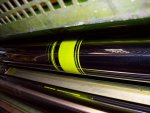Kaoticor
Well-known member
Press: Komori Lithrone 28
Fountain Solution: Flint Supreme 8168
Ink: Toyo 24/7
Description of Problem: Ink building up on chrome roller in dampening system (not the chrome water pan roller, rather, the chrome oscillator that bridges the form and the metering roller). Unit 4 is very bad, and a slight build-up is noticed on unit 1. Appears to be a ink/fountain solution chemistry, but we have ran both of these products for quite some time without any related problems. Has happened since 2-3 weeks ago. A picture is attached of problem.
Remedies tried:
Thorough flushing and hand cleaning of dampening system
Dampening filters changed
Hand cleaned and gummed (tried both buffing dry and sitting dry)
Used Comet cleaner lightly with gum aplication afterwards
Triple checked all pertinent roller settings
Checked soft roller duromoters and conical tape measurements
Swapped out metering rollers with non-problem units
Tried flushing and remixing fountain solutions at different pH and conductivity levels. (Currently 2800 conductivity at 4.3 pH, 3.8-4.5 recommended by Flint)
Adjusted a wide range of ratio settings (130-180)
Adjusted settings heavier and flooded damening system with solution (Ink build up still took place)
Different styles of washdowns (although we are always very thorough and consistent washing down and have been for years).
Additional notes: Again, we have used both the fountain solution and the ink for quite some time now and have not had any problems even closely related to what we are experiencing now.
I appreciate any and all feedback you might have and for taking the time.
Fountain Solution: Flint Supreme 8168
Ink: Toyo 24/7
Description of Problem: Ink building up on chrome roller in dampening system (not the chrome water pan roller, rather, the chrome oscillator that bridges the form and the metering roller). Unit 4 is very bad, and a slight build-up is noticed on unit 1. Appears to be a ink/fountain solution chemistry, but we have ran both of these products for quite some time without any related problems. Has happened since 2-3 weeks ago. A picture is attached of problem.
Remedies tried:
Thorough flushing and hand cleaning of dampening system
Dampening filters changed
Hand cleaned and gummed (tried both buffing dry and sitting dry)
Used Comet cleaner lightly with gum aplication afterwards
Triple checked all pertinent roller settings
Checked soft roller duromoters and conical tape measurements
Swapped out metering rollers with non-problem units
Tried flushing and remixing fountain solutions at different pH and conductivity levels. (Currently 2800 conductivity at 4.3 pH, 3.8-4.5 recommended by Flint)
Adjusted a wide range of ratio settings (130-180)
Adjusted settings heavier and flooded damening system with solution (Ink build up still took place)
Different styles of washdowns (although we are always very thorough and consistent washing down and have been for years).
Additional notes: Again, we have used both the fountain solution and the ink for quite some time now and have not had any problems even closely related to what we are experiencing now.
I appreciate any and all feedback you might have and for taking the time.














